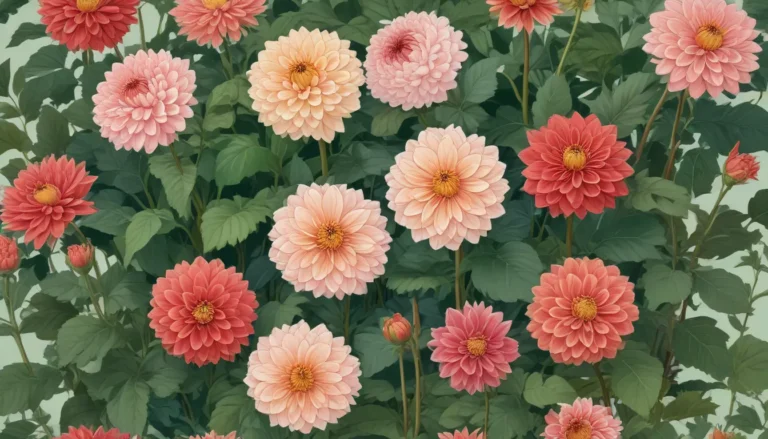A Comprehensive Guide to Growing and Maintaining Bonsai Apple Trees

Have you ever seen a bonsai apple tree in full fruit? The striking contrast of tiny apples on a miniature tree is truly captivating. Growing bonsai apple trees is not only about the visual spectacle of the fruit but also the art of shaping a hardwood tree into a dramatic piece of living art. Whether you are a seasoned bonsai enthusiast or a beginner looking to embark on this unique journey, this comprehensive guide will provide you with all the information you need to successfully grow, shape, and maintain your own bonsai apple tree.
What You’ll Learn
Before delving into the intricate details of growing a bonsai apple tree, let’s cover the basics to ensure you have a solid foundation. Whether you are new to bonsai or a seasoned gardener, understanding the key principles will set you up for success. In this guide, you will learn about:
- Soil
- Potting Up
- Watering and Fertilizing
- Winter Care
- Shaping Techniques
- Pruning Tips
- Repotting Guidelines
- Cultivar Selection
- Pest and Disease Management
- Fruit Production Expectations
Now, let’s explore each of these topics in detail to help you nurture your bonsai apple tree with confidence and expertise.
Soil: The Foundation of Bonsai Growth
The soil is not simply a medium for anchoring the tree, but a living entity that sustains the health and vitality of your bonsai. Good bonsai soil should contain beneficial microorganisms, organic matter, adequate air circulation, and proper water retention. If you are just starting out, consider using a pre-made bonsai soil blend to simplify the process. This will ensure that your tree receives the essential nutrients and moisture it needs to thrive.
- Recommended Product: Bonsai Soil All-Purpose Blend
This blend, composed of lava rock, limestone pea rock, calcined clay, and pine bark, provides an ideal growing environment for your bonsai tree.
Potting Up: Establishing Your Bonsai Tree
When potting up your bonsai apple tree, ensure that the container size is proportional to the tree’s height. The roots should be trimmed to fit comfortably within the desired container, allowing room for growth and development. Focus on the roots rather than excessive pruning of the branches to support the overall canopy structure. By selecting the right pot size and potting medium, you can create a conducive environment for your bonsai tree to flourish.
Watering and Fertilizing: Nurturing Your Bonsai Tree
Proper watering and fertilization are crucial for the health and growth of your bonsai apple tree. Always water your bonsai at the soil level to avoid wetting the foliage. Keep track of the soil moisture by testing it periodically and adjust your watering schedule accordingly. In addition, regular fertilization is essential for providing the necessary nutrients for fruit production. Choose a balanced fertilizer with essential nutrients such as nitrogen, phosphorus, potassium, and micronutrients to promote healthy growth.
- Recommended Product: Bonsai Fertilizer Pellets
These slow-release fertilizer pellets are formulated specifically for fruit trees and provide long-lasting nutrients for optimal growth.
Winter Care: Protecting Your Bonsai Tree
While bonsai apple trees require exposure to the changing seasons for fruit production, they also need protection during harsh winter conditions. In regions with freezing temperatures, consider placing your bonsai in a cold frame or unheated greenhouse to shield it from extreme cold. Wrapping the container with insulating materials can provide an extra layer of protection against frost. Remember that bonsai trees are more vulnerable to cold stress in containers compared to those planted in the ground.
Shaping and Pruning: Sculpting Your Bonsai Tree
Shaping and pruning are essential aspects of bonsai artistry that require patience and meticulous technique. When shaping your bonsai apple tree, aim to recreate a natural tree form rather than forcing unnatural shapes. Avoid aggressive pruning and focus on gradual shaping over time. Pruning during the winter is optimal to promote fruit production and maintain the tree’s health. Remove excess fruit and maintain a balanced canopy structure to ensure optimal fruit development.
Cultivar Selection: Choosing the Right Variety
When selecting a cultivar for your bonsai apple tree, consider factors such as tree size, fruit characteristics, and growing conditions. Crabapples are popular choices for bonsai due to their compact size and proportional fruit production. Look for self-fertile cultivars that do not require cross-pollination for fruiting. Some recommended cultivars for bonsai apple trees include ‘Harvest Gold,’ ‘Honeycrisp,’ and ‘Jonathan,’ known for their ornamental value and fruit quality.
Pest and Disease Management: Preventing Common Issues
Bonsai apple trees are susceptible to pests and diseases that can affect their health and fruit production. Monitor your tree regularly for signs of pests such as scale insects and wooly aphids, which can damage the bark and foliage. Implement preventive measures such as soapy water treatments to control infestations. Additionally, watch for common diseases like powdery mildew, fire blight, and root rot, and take prompt action to prevent further damage to your bonsai tree.
Fruit Production Expectations: Patience and Persistence
Growing bonsai apple trees is a rewarding but time-consuming endeavor that requires patience and dedication. While you may expect fruit production within five to seven years for bonsai apple trees, the timeline can vary based on growing conditions and tree age. Remember that bonsai art is a long-term commitment that rewards you with unique and beautiful creations. Enjoy the journey of nurturing and shaping your bonsai tree, and celebrate each milestone along the way.
In conclusion, bonsai apple trees are a captivating addition to any garden or indoor space, and with the right care and technique, you can cultivate a stunning masterpiece in miniature. By following the guidelines outlined in this comprehensive guide, you can confidently grow, shape, and maintain your bonsai apple tree with expert precision and artistry. Embrace the art of bonsai cultivation and revel in the beauty of your unique and enchanting bonsai creation.
Share your bonsai apple tree journey with us in the comments below and inspire fellow bonsai enthusiasts with your horticultural artistry! Remember that each bonsai tree is a living work of art that reflects your creativity and passion for cultivating nature in miniature form. Happy growing and shaping your bonsai apple tree masterpiece!
In reimagining this article, we have explored the intricate nuances of growing bonsai apple trees with a conversational and informative approach. By incorporating detailed insights on soil, potting, pruning, cultivar selection, and more, we have enhanced the reader’s understanding of the art of bonsai cultivation. Through practical recommendations and expert advice, we aim to equip gardening enthusiasts with the knowledge and tools to embark on their own bonsai apple tree journey. Let this guide inspire and empower you to create a captivating bonsai masterpiece that will be the apple of your eye for years to come.





